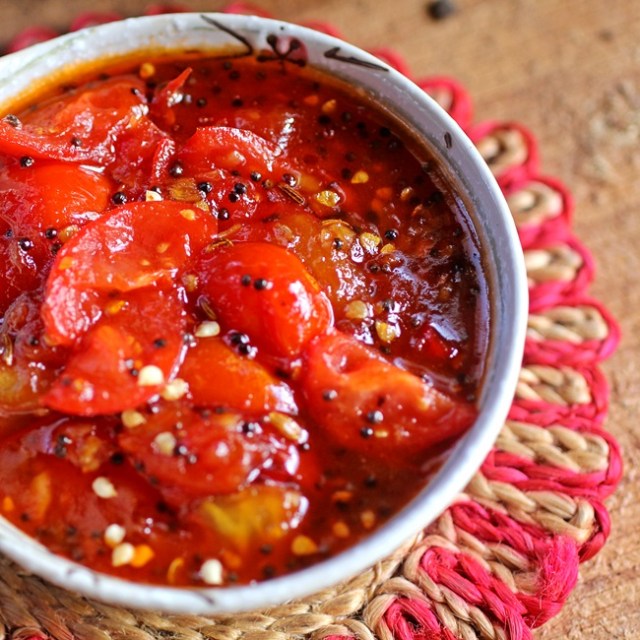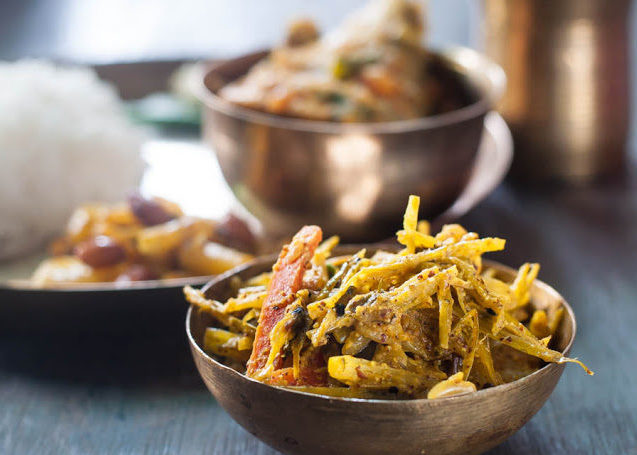When you are the inept daughter of a famous cook, and even worse, you confess that you don’t like cooking, then you spend a lot of time apologising to the world. Even a stack of published books could not make my Ma forget all my culinary disasters, like the time when I managed to burn a pot of rice to a black crisp because I was sunk into a book.
It is not easy being the absent minded daughter of a Bengali Mother Chef.
After Ma had quietly slipped away one night it took me months to find the courage to go through her bedside table where she kept all her papers. Among them there were two yellowing writing pads where at our request, she had jotted down some of her favourite recipes, protesting all the time that she did not know how to measure in spoonfuls. She was a traditional cook, all instinctive estimates or ‘andaaz’ and the sniffing of the frying masala. Even in her eighties when she could not see too well she never got the masala wrong.
The recipes were of interest to the cooks in the family and so I keyed them into my computer and offered them to the world on Facebook. Within hours I was inundated by requests and many thank you emails came with photos of the cooked dishes.
Here’s a brinjal recipe that is from Shimla that most Bengalis would be unfamiliar with. My Didima persuaded a dhaba owner at a bus stop to part with his secret. It is surprisingly easy to make, very healthy as it is made without any oil and really delicious.
KHATTA BAINGAN
Brinjals – 750 gm
Haldi – 1 ½ tsp
Mirchi – 1 tsp
Dhania powder – 1 ½ tsp
Hing – one pinch
Salt
Amchur 1 ½ tsp
Green chilly – 2
Ghee – 1 tbsp
Wash and dice the brinjals. In a karhai put all the brinjals and add 2 cups of water. In the water put all the masala and salt, except the amchur. Add the green chilly. Cover the karhai and let it cook till the brinjals are tender and the water has dried completely and then mash them well. Add amchur and ghee. The dish is creamy and goes well with paranthas and rotis.
For Ma all good Bengali girls cooked and so she taught me very carefully. If required I can produce a full meal but I could never muster any genuine interest in cooking. Typing out the recipe for charchari I flashed back to our kitchen as she showed me the exact way in which each vegetable had to be chopped, the potatoes in slices, the spinach in chunks, the pumpkin in cubes and the patol peeled in stripes. As I watched breathlessly, Baba and Ma tasted my first attempt at the iconic Bengali dish.
My kind Baba grinned and said “Not bad at all!”
The Mother Chef chewed grimly and then declared, “You burnt the panch phoran… I told you…”
My two grandmothers were absolute contrasts when it came to their attitude to cooking. My Didima was the original Mother Chef who collected recipes from everywhere including wedding chefs and dhaba cooks. Her recipes are treasured by the family and a cousin has collected them in bestselling recipe books. For Thakuma, the imperious zamindar’s daughter, cooking meant you instructed the cook on the menu and then went off to focus on ringing the bell and loudly chanting mantras in the pujo room. If Thakuma cooked anything the whole family would applaud, so not to spoil us too much she hardly ever did so. Even after decades I still miss my Didima’s tomato chutney that she would give me in a special enamelled bowl.
TOMATO CHUTNEY
Tomato – 1 kg, finely sliced
Ginger – 1 inch piece, finely sliced
Sugar – 200 gm
Mustard seeds – 2 tsp
Salt / oil
Heat 2 tsp of oil, add mustard seeds. Add tomatoes and salt and let it boil in its own juices till tender. Mash the tomatoes and blend together. Add sugar and ginger pieces and put on low hear till thick.
Ma was born in Delhi and her family has been here for over a century. So her recipe collection spread to Delhi dishes and her stuffed potato parathas on a cold winter day were to die for. Here I am giving her delectable keema dish with methi leaves that was always made in winter as also methi paranthas and methi with potato sabzi.

KEEMA METHI FRY
Keema – ½ kg
Green methi leaves – 250 gm
Onions – 4 (finely sliced)
Ginger paste – 1 tsp
Garlic paste – 1 tsp
Vinegar – 2 tbps
Mirchi powder – 1 tsp
Salt
Oil -3 tbsp
Clean and pick the methi leaves, discard the thick stems and wash thoroughly. Wash the keema. Heat oil in a pressure cooker and fry the onions till golden brown. Add the ginger and garlic paste. Add mirchi powder and stir. Add the keema and fry for a while. Add the methi leaves, vinegar and salt. Fry for a few minutes and add half a cup of water and pressure cook for 15 minutes. Do not add any water as a lot of liquid will come out of the methi leaves and will cook the keema. The dish will be dry and creamy.
One day as I was sorting through old photograph albums I found the perfect portrait of Ma. She is standing at the door of our dining room holding a giant thali piled with puris. Her face is split by a triumphant grin as if anticipating our joy at her amazing cooking that was always spiced by dollops of love.
~~~~~~
Cover photograph of Bengali charchari, courtesy: www.ahomemakersdiary.com
Tomato chutney, photograph courtesy: www.spicechronicles.com
Photographs representational

